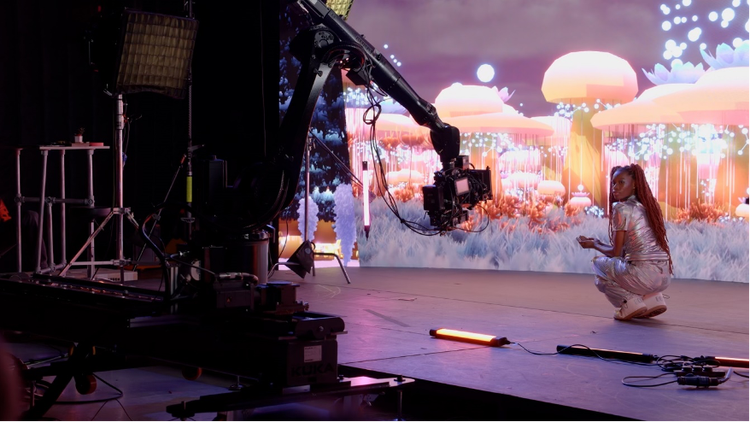WPP designs innovative experiences for emerging media with Substance 3D Collection

Perry Nightingale has always been fascinated by the intersection between communication and technology. In his role as senior vice president of Creative AI at WPP, Nightingale supports the groundbreaking research and innovations that have made WPP one of the world’s top marketing and creative companies.
“WPP artists work on everything from product and packaging design to television advertising to exploring new forms of media,” says Nightingale. “One thing about creativity is that it’s never standing still. Half of the creative jobs at WPP didn’t exist 10 years ago, and yet creative skills are often taught the same way as they were 40 years ago.”
To better prepare WPP to fulfill new creative demands — including immersive experiences, augmented reality, and virtual productions — the company decided to train talent themselves. The WPP Creative Technology Apprenticeship program invited 16 creators to push the boundaries of emerging media and technology. Nightingale, along with Kat Sullivan, senior director for Interactive Design at WPP, designed a curriculum that taught apprentices to create 3D experiences using solutions such as Unreal Engine, NVIDIA Omniverse, and Adobe Substance 3D Collection.
“Many of the apprentices already have extensive experience with Adobe Creative Cloud apps,” says Sullivan. “Substance 3D Painter expands upon this familiar creative pipeline to bring art from 2D into 3D quickly and efficiently so that they can focus on innovation in new mediums.”

Embracing diversity in creative spaces
When thinking about what kind of people WPP wanted for its Creative Technology Apprenticeship, the company looked for voices from a variety of ethnic, cultural, and creative backgrounds.
“If we keep using the same voices, we risk creating the same thing,” adds Sullivan. “This is the most diverse room I have ever walked into.”
Each apprentice created a 3D character from scratch. Not all had previous experience working with 3D models, but it took just one short workshop to start applying materials and textures with Adobe Substance 3D Painter.

Illustrator Ning Wei created a bunny wearing an intricate mask inspired by “face-changing” performances from Chinese Sichuan opera. Since Wei had never worked in 3D before, she appreciated how she could apply embroidery, patterns, and colors directly to the model rather than trying to work with a flat UV map. Using Adobe Aero, she also learned to add interactive animations in AR.

Designed by Ning Wei.
Adele Loye spent over 20 years working in the architectural field before she decided she needed a more creative challenge. Her character embodies Afro futurism, inspired by her Nigerian and Jamaican heritage and her love of technology and design. She discovered the importance of having diverse voices in 3D art as she struggled to find any braids for her character’s African hairstyle on the marketplace. She resorted to manually braiding the hair in 3D, but with Adobe, texturing her character was much easier.
“The idea behind the character is that she carries stories in her skin, so I had this vision that it would look like a circuit board,” says Loye. “I loved how Adobe Substance Painter made it so easy to apply a circuit board texture and then turn it a bronzy gold to mimic African art. It took me 30 minutes in total to apply and adjust the skin.”

Designed by Adele Loye.
Tilly Cullen has a strong background in graphic design, coding, and technology, but she had never worked in 3D. She and her team, Jade Pughe and Rocio Rey, created characters that would help teach young people how to use electronics. Using the stamp tool in Substance 3D Painter, they applied symbols such as pluses and minuses to show how electricity flows through the characters. Substance 3D Designer allowed her to create custom textiles, such as embroidered patches to indicate voltage levels for different characters.
“We imagined our character as part of an AR experience combined with physical components, so we mocked up the physical kit and did a virtual photo shoot in Substance 3D Stager,” says Cullen. “I liked how Stager made it easy for people to visualize our idea as something real.”
Exploring the future of creativity
Nightingale believes that both 3D and artificial intelligence have the potential to increase speed, decrease cost, and help human artists focus on creativity. Photoreal 3D allows artists to create visuals quickly and efficiently, eliminating the need for expensive and time-consuming photoshoots. Features powered by AI in Adobe apps, such as object selection, can dramatically reduce time spent editing images, saving WPP millions in productivity.
“I also see huge upside for generative AI through the potential of scale,” says Nightingale. “Say you want to construct 10,000 images of cakes for a campaign. Generative AI could be a big time-saver. What I love about the potential of something like Adobe Firefly is that it helps make sure the generated images are compliant, legal, and reward the creative community.”
WPP wants to continue reaching larger demographics with experiences that wow them. That’s why both innovation and diversity are critical to WPP moving forward.
“What I’m most proud of is that we are diversifying creative tech,” says Sullivan. “I get very excited to see new faces finding confidence in themselves by using Adobe to create experiences on the forefront of emerging technology.”